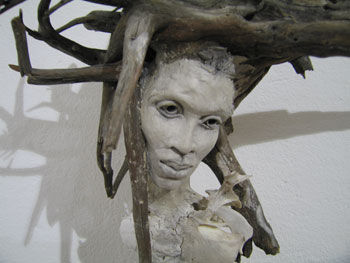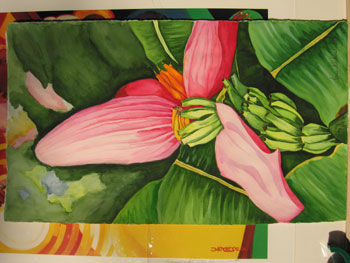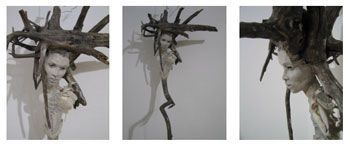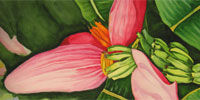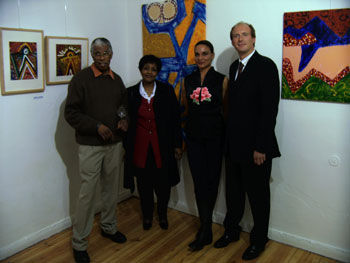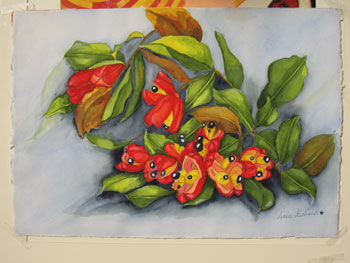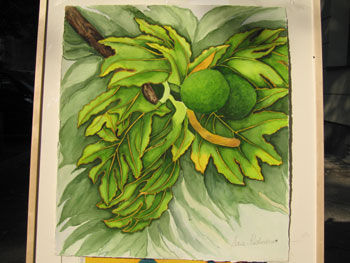
The concept of Caribbean Art Collection is to work as a mobile gallery using art as a media to expose the caribbean culture throughout Europe. The base is Berlin Germany. We not only have art shows but have been offered the give seminars of information about the Caribbean. Since its openning in November 2004, Caribbean Art Collection is slowing becoming a cultural information source here in Berlin, A Journalist for example, from an Encyclopedia specailizing in Latin America and Caribbean artists visited us to get information about Jamacan artist whose last name ends in „G“. This will be the first time Jamaican artist will appear in this well known encyclopedia. More and more cultural organizations are becoming interest.
Caribbean Art Collection seems to satisfy a cultural bridge that has not yet existed here in Europe. Attendance to our vernissage is growing but because the actual sales of art is yet low it is necessary to find sponsorships and/or people or organizations for mutual support.
One of the main goals of the Caribbean Art Collection gallery is to support Caribbean art and artists as well as supporting social projects in the Caribbean. The gallery is the brainchild of founder Jamaican Lydia Tulloch-Déhee. Here is an interview with Lydia Tulloch-Déhee.
Where in Jamaica are you from and when did you leave? Do you visit often?
I was born in Kingston Jamaica and left when I was twelve years old to finish school in New York, USA. Destiny and influence from my social circle then sent me on to Dar-es-Salaam, Tanzania which had a great impact on my self awareness. My mother had worked with the United Nations in N.Y. and its headquarters moved to Geneva Switzerland where I stayed with her for a while before going on to Paris, France where I was offered a career as a model and dancer. A german fashion scout Helmuth Lang came to Paris looking for models and I was chosen. My life was literally just travelling all over the world until I finally settled here in Berlin. I re-discovered Jamaica when my son was born and have been going back regularly at first every 2 years and now almost every year.
Where did your initial interest in Caribbean art come from?
There are cultures that feel like going into a time machine and living in a civilization which is read only in books. Coming into my mind now as I write this I think of Dubai, Morocco, Dar-es-salaam, Jakarta and Haiti. I still have a wooden statue here in Berlin that I brought here to Berlin with me from Haiti via Paris and Geneva after going there with the fasion designer „Paco Rabanne“ in the 80‘s.
Even after my career as a model and dancer was over my family and I kept on travelling into Africa and southern Europe. I had learnt french and with english it is pretty easy to get around in this world. When visiting for example Agadir, Morocco I would be jogging on the beach and people would ask me where I came from. I would say of course Jamaica. It took them just a day or two to follow me on the beach and sing Bob Marley songs. The social and political problems of Jamaica are similar to the problems that most lands of the world have. Even if they don’t understand what he is saying they identify with his energy and image.
In many ways through my travels, I witnessed how Jamaica has influenced the world, not only the so called third world but also the industrial world. When my son was 2 years old (he is now 13) my husband asked me why don’t I want to go back to Jamaica and introduce him to my father. Of course, I was deeply touched and wondered myself why.
My parents were separated when I was very small and I grew up with my father until I was sent to the USA. I hadn’t seem him since I went to Tanzania. I was astonished that we were so much alike, our basic instincts, it was incredible almost frightening. My father was also a collector – of antique furniture, rum (he was the master blender of the Jamaica Rum CompanyHe loved Jamaica). He loved caribbean women. he loved life! His second wife after separating from my mother was Haitian. When I entered his home I saw a haitian painting of a woman smoking a pipe. I said „Daddy, you don’t want to give me this?“ Although my father really loved me very much, I know this for sure, he answered „Lydia, everywhere this painting goes I go“. I am also a born collector we can understand this attachment for certain things.
Eight years later my father died. He did not forget, he kept his word. In his will he specified „I want Lydia to have the painting of the woman with the Pipe“. The intensity of what I felt with this jest is the energy and reasons for Caribbean Art Collection.
You have lived in quiet a few countries including the USA, Tanzania, Switzerland and France. What were the aims or guiding principles behind the establishment of the gallery?
Was living in these other counties one of those guiding principles?
Yes, I did live in quite a few countries. Like I mentioned before, I was not consciously guided to establish a gallery. Actually, I didn’t know much about the bureaucratic and technical skills of a gallery when I started and I am still learning. The cultural side, I am beginning to see how important it was to accumulate all these experiences. Like the different languages and cultures of the world. Especially when a person travels and become part of another culture, perform and even suceed in this other culture, they become nostalgic and protective of their own. They find that they need to go back and get to know where they came from, who they are and try to find out about the history of their people. This gives the confidence you need so that even if someone else see or defines you different you know who you are. I went home before starting the gallery and got the opportunity to be guided and supported by some very strong Jamaicans in Jamaica and they gave me the path and beginning when I seeked help two years ago in finding a solid foundation the build from. This support and knowledge from home and what I learnt while travelling is a definite plus for the gallery.
When you first arrived in Germany in 1992, was there any galleries showing Caribbean art? Was Caribbean art readily available to acquire?
Caribbean Art, african art, eastern art was always shown and expolited in Europe, it helped build europe only no credit was given to it. Picasso Dali Gaugen among others all went to the third world and was inspired then marketed our art. They were given the credit. They became the masters that everyone seems to follow and only later acknowledged where they got their inspirations. Egyptian art is all over Paris, all over the world only the noses of most of the statues are broken off credit was given to the european race. Caribbean art what african has art has developped into in our hemisphere , no there are no other galleries here specializes in it.
Where did you buy the majority of your gallery collection?
Most if not all of my pieces are now from Jamaica and are on consignment. This year 2004-2005, the beginning, is Jamaica by jamaicans. The beginning of next year is planned to be concentrating on Haiti under the auspices of the Haitiian ambassador Saget. More we be said about this in the coming year. Financially the gallery cannot as yet purchase to speculate.
You recently visited Jamaica. Poverty, Violence and killing are prevalent in Jamaica. Do you see this being reflected in the work that you review to display in your gallery.
I did visit Jamaica recently. I was walking around all day sometimes by myself and didn’t witness or was affected by killing and violence or any kind of aggression. One reads that in the media or maybe I was lucky. When you first get there you are also affected mentally by this fear but after a while you start letting loose and talking to people and the feeling is just the same way as in any other city even here in Berlin. One should be careful where and when to walk around. Where and who and how to address people. How to get around without being provocative. I did that in Dar-es-salaam, in Bankok , Haalem USA Caracas Venezuela etc. when I was travelling. In some places in East Berlin, I feel much more threatened than walking around in the streets of Jamaica although nothing until now has ever happened but just from what one hears. Jamaica is a beautiful country. Many europeans critize and say that they feel at danger mostly because they assume that they have the right to walk around the world at any time and be safe, they forget what it is like for many foreighners who look a little different to walk around in their countries.
I do have a few pieces that reflect the political and social life in Jamaica. All good art reflect the environment and artist that created it. That’s what art is. Even primitive art by the cave men as simple as it was is indispensable for the human race. It gives us an idea of what our civilization was like and we can see civilizaton’s development. Art keeps us informed about a society. Even if it is only a banana blossom that grows in the Caribbean like Sonya Richards’, it is important, who knows maybe a lot of tropical fruits will be extinct after a few generations.
The absence of art is also political. I opened “Caribbean Art Collection” under the auspices of the jamaican ambassador Hon. Marcia Gilbert Roberts in the Etnological Museum of Dahlem in Berlin. Etnological meaning non-european art. At this museum only cultures like africa, asia etc. are acknowledged. As I understand it they do have some art from the caribbean but the Caribbean as I was informed is not considered a culture itself but a combination of many cultures, a sub-culture. Could you imagine if we could succeed in exposing in an established european museum Professor David Boxer’s microcosm of the transportation of slaves into America as to be seen in the National Gallery of Kingston. To learn about the moroons (they talk about the original inhabitants the arawaks dying out and stop there. As if the history of how african people forced into slavery kidnapped and robbed of their dignity but still had the strength to take over most of the caribbean is not worth while mentioning. Or “The Haitians are celbrating two centuries of Fredam, two centuries since their slave ancestors rose in revolt to throw the Franch colonizers out. They had to do it twice, when Napoleon, newly installed in France, tried to recapture the richest colony in the world for his country. The Haitians threw out a British army too, but neither of these extraordinary and heroic feats is reflected in our history Books.” These positive recognition would glorify the character of these people. Is it just a coincidence that our art and culture is ignored in european museums and galleries. Don’t they know that it would be good for society in general when we start rebuilding ourselves and out countries. .
My aim is to inform through art and to bring different people together. To give people of colour a chance to meet up with others and enjoy the same podium
You have stated that one of the main goals of the gallery is to support Caribbean artist and to support Caribbean art and artists as well as supporting social projects in the Caribbean. Tell us more about these efforts and what you have accomplished?
Caribbean Art Collection gives 5% its profit through the ambassador of the courtry of origin of the artist for some recognized project. The Jamaican ambassador has chosen “YES” Youth Educational Service. It is a project to reeducate young prople who could for some reason or another not finish school teaching them skills that would enable them to get jobs in Jamaica. On my last trip to Jamaica I visited the project and was very proud that I could somehow take part even if it is just a little.
The artist in the country gets 50%. But more than that recognition and exposure for himself and his country. At the beginning of a collection the artist is also usually present.
Can you talk about your work with Caribbean governments with embassies in Berlin and what they are doing to help?
The project was made possible by the german government who had a programme to support small businesses. Once accepted, they sent me to school to learn about setting up a business and then offered me organizational help along with a small minimum salary. The different caribbean embassies especially the jamaican embassy have also been a backbone since the beginning.
The ambassador of the different caribbean land functions as a bridge of confidence between Caribbean Art Collection and the chosen social project and is usually present at the functions as symbol and to give information if necessary.
As a gallery owner I know you have to be diplomatic but who is your favorite artist right now?
The more I live art the more confused I am about what my favourite is. I am glad I have the gallery to be able to change my taste so often.
Do you have any advice that you could give to beginner collectors of Caribbean art about how to start a collection or some pointers to look for when buying Caribbean
art?
You have different kinds of collectors. Normally by collectors we speak of people who buy as an investment. Maybe they look for an artist who they feel will one day be in demand and buy them cheaply in the beginning with the intention of reselling with profit. Others buy an art of a recognized artist for social recognition or again possibly reselling. Or maybe they collect from that particular artist. Still there are those who can be influenced when they come into a gallery by technique and names. Or they are caribbean fans and want to support the project. Or mixed marriages with children who need some kind of positive images. Then there are others who look at something and feel for it and if they have the means to take it with them. There are no rules all ways are correct.
If you were to look back at the Caribbean art pieces that you’ve collected over the years: what would you say were the criteria that guided your selection of them?
Actually my first collection was not only caribbean. I was probably more motivated by not being able to be in different places when one wishes. When I took back a piece I was actually trying to take a culture with me it is always so hard just leaving places without something to remember them by. My first collection was Masai jewelry and ebony wood carvings I used to be fascinated with them when I lived in Tanzania. Later I was attracted to Haitian carvings then Jamaican colours. I enjoy the figurative paintings of Bryan McFarlane, Professor McFarlane studied with, among others Barrington Watson. He is a moroon who is now a professor of art at University of Boston Massachustees. We have a painting by him “The Eggs that Hatched”. It is a huge painting of his mother and father aunts and uncles on their wedding day. You should see it. Black black skin all dressed in white – beautiful. When I had it in the front of the gallery everybody had to stop. Such paintings are rare. I don’t even think Bryan could paint it again if he wanted.
When the decision was made to actually start Caribbean Art Collection, I went back to Jamaica and looked for advice. We had been preparing for the trip for about a year before. I had written almost all UN agencies and asked for help. One answered and I got an interview with Mr. Alwin Bully. We stayed in Lethe, St. James and spent many nights organizing before going on this interview. While there in Jamaica, I also interviewed Professor David Boxer, curator of the National Gallery in Kingston and visited the Edna Manley School of Arts and met with Cecil Cooper, the head of the visual arts department. These three people’s advice and guidance and my own instincts along with a very good working team is until now my guide. What is now Caribbean Art Collection actually started about 3 years ago. It was launched officially a year ago. It has not even begun to be. It is still very much in its development stages
Tell us about your first Caribbean Art Exhibit? What was the response to this type of exhibition in Germany at that time?
The opening was at the Museum of Ethnological Art, Berlin. There were about 150-200 people attending. Jamaicans and many europeans from all over Germany not only Berlin. It was prestige to be able to give the openning at the Museum with representatives of all 4 embasssies of the independent Greater Antilles. (Haiti, Cuba, Jamaica and Dom Rep). Also present were 3 great Jamaican artist – Cecil Cooper, head of the art department at the Edna Manley School of Art in Kingston Jamaica, Professors Bryan McFarlane and Professor Kofi Kayiga both Jamaican born and living in the USA. Cecil Cooper had also brought along works from Alexander Cooper, Nakkissi Hutchinson, and many other Jamaican artists. Their were a lot less people than would have come if there had not been a 20€ entrance which most people thought was too much and many were complaining at the entrance, some turned back. The vernissage was done in co-operation with the Es-culture (the restaurant in the Museum of Dahlem). The money went to the restaurant in return of catering – food and drinks. The restaurant had also arranged the contact with the museum. For this fee there was an unlimited buffet of Jamaican Foods and a Concert by Cecil Cooper, also a known vocalist in Jamaica. Of course 5% of the entrance fee or what would have been sold would return to Jamaica. Most people did not even look at the art but was trying to get as much food as possible for their money. They complained that the rice and peas etc. did not taste as good as it should. And most stayed the whole night on lines waiting for again more food for their money.
Culturally it was a success a lot of Jamaicans had not seen each other for a long time and this was an opportunity. In general everyone was very proud some complimented me on being able to accomplish showing Jamaican art in a Museum. The then haitian embassador M. Brier, was the only one who contributed by buying a painting to encourage the concept. It was a let down as far as the actual vernissage was concerned I had prepared it for at least 2 years before. But being the first show and not having any experience I sat down and tried to anlyzed what went wrong, First I decided – no more food at the next vernissages.
As as a mother, every time I see a child of colour or when my son goes out by himself in the streets of Berlin or pass another black on the street and they look away or think about my father, it makes me want to continue. I want to scream out „don’t you know how beautiful you are“. Don’t you know your history. This is what I am doing by „Caribbean Art Collection“. It means a lot to me. Before when I would look at TV and saw all these negative images that is shown about our people, I would say to myself, „I wish I could do something“. But it becomes clearer and clearer that this project is only possible if it is done all the way and gets exposed in the right circles.
There are people who think that I am starting too big. There are people who feel more comfortable when a person acts within a certain limit and steorotype. These people are both black and white. They feel that as long as you are loyal to their image, to their sterotypes the ones that they dictate for you, you are alright. When it is in down beat and exploits the rasta culture (what they see as rasta!) they can relate to it and feel comfortable. They feel that that is the only Jamaica. On the television you see the slums and drugs and killings, this goes along with what they think is rasta. Africa is only shown with aids and need !their” help. Even one Jamaican woman criticized me when I asked her for help „if I act like a millionaire then nobody will think I need help“. I refuse the come down and compromise before that I stop. Our culture should be in the best of places it has been down too long . When I was growing up even when times were hard nobody from the outside would know about it. Even when we as children were invited, we would eat first and when we got to the people’s houses we would say no thank you, we are not hungry. We were always taught to be proud and well dressed, walked tall. That is the Jamaica that I know. These are the values I learnt and would like to show and teach the world- The real character of Jamaicans what make us suceed no matter where we are in this world.
I visited Berlin early this year and did not find any Caribbean restaurants. Where do you go for Jamaicans food?
There are a few caribbean restaurants in Berlin. One Jamaican restaurant, some cuban, quuite a few Mexican. There are quite a few caribbean bars. In general the german people here like the taste of exotic. When the economy gets bad people eat more. Food and music is always good business.
Has the growing African community in Germany helped with diversity?, What are some of the things people said and what are some of the questions people asked you about the Caribbean?, As a Jamaican living in Europe what are some of the stereotypes you encounter?
At first I would say no. Then when I think about it I realize the answer is yes but we have to get into different levels of diversity. There are more and more what they call multi-kulti (multiple cultural) events. Meaning mixed european and non-european events. There are more and more mixed couples. At first it was just in certain neighbourhoods but now you see that the population of Berlin is changing. I myself am married to a French man and we have a son. When we visited America (Miami) 3 years ago the police at the border stopped us and asked me „what my relation was with those 2 people“. It was confusing to them that my son speaks german, my husband french and I, a black woman had to translate into english. In one little famile the three languages being used. For us it is normal, I had forgotten the racial barriers in America.
Although now in europe there are more and more children of colour most don‘t belong to the group that can really change things. They are not organized. They are not encouraged to keep their identity. They try to fit into the culture as best they can. Some grow up not knowing where one side of the family comes from and in the schools they still have the same teaching from back then when the german race was supposed to be „clean“. Unlike America they don’t have unions or groups to represent them. They have no heroes to be proud of. They are an uncomfortable situation that someday has to be faced like in France this year. Most of them have parents that fall into the category of the white woman who has taken on a black man who in turn might have problems integrating, or the white man who travelled and brought back a young black or asian woman. If accepted a lot of us try to be good Germans and protect what we have accomplished.
Europe is rich in historic art and many visitors’ travelers go to Europe for them. Do you see a niche for Caribbean art in a market that is dominate by European art?
Definitely, there is a definite demand for art in general in Europe. As far as caribbean art is concerned, the europeans especially the germans are very much into the idea of going back to nature, like I said, they love the exotic. They are very curious and have a passion for the unusual. Germany especially Berlin was once the art capital of Europe and is slowly regaining this reputation. They have a very high standard of what art is and the possibility of much exposure. It has to be very well done and authentic. In Jamaica, we have really good art that would fall into this category, I say Jamaica now because for the first year concentration was only on Jamaica. One of the main critiques that I encounter from clients who visit the gallery is first they feel a lot of the art is overpriced as the artist are not known. Others feel certain art expressing too much studing of established european artists. To be influenced by a certain school is good but the talented go beyond technique and expresses his own feelings and environment. The europeans are looking for paintings that takes them into another world something that they can not find here, whether or not it is done by caribbean artist. We have these arts. I have seen them.
Where do you see the future of Caribbean Art in Europe going? What are the main challenges for Caribbean Art and how they can be overcome?
Yes, there is definitely a market. Right now the economy is low and art is a luxury item to buy. Now there is a very important cultural exchange. It is getting to know and respect another angle of a culture that they already know. To get rid of the association with old stereotypes. In Germany, people have to get used to an idea before they react. Like friendships here, it takes a long time to start, but then when it does , it is really a deep and lasting confidence that one can count on.
Thanks for your interview? Any final words?
Please censor when you think it is offensive to anyone. These are my experiences in this time and place. It is not necessarily the perspective of someone else or even of myself in a few years or yesterday. I open up to you although I don’t know who you are but somehow feel trust.

